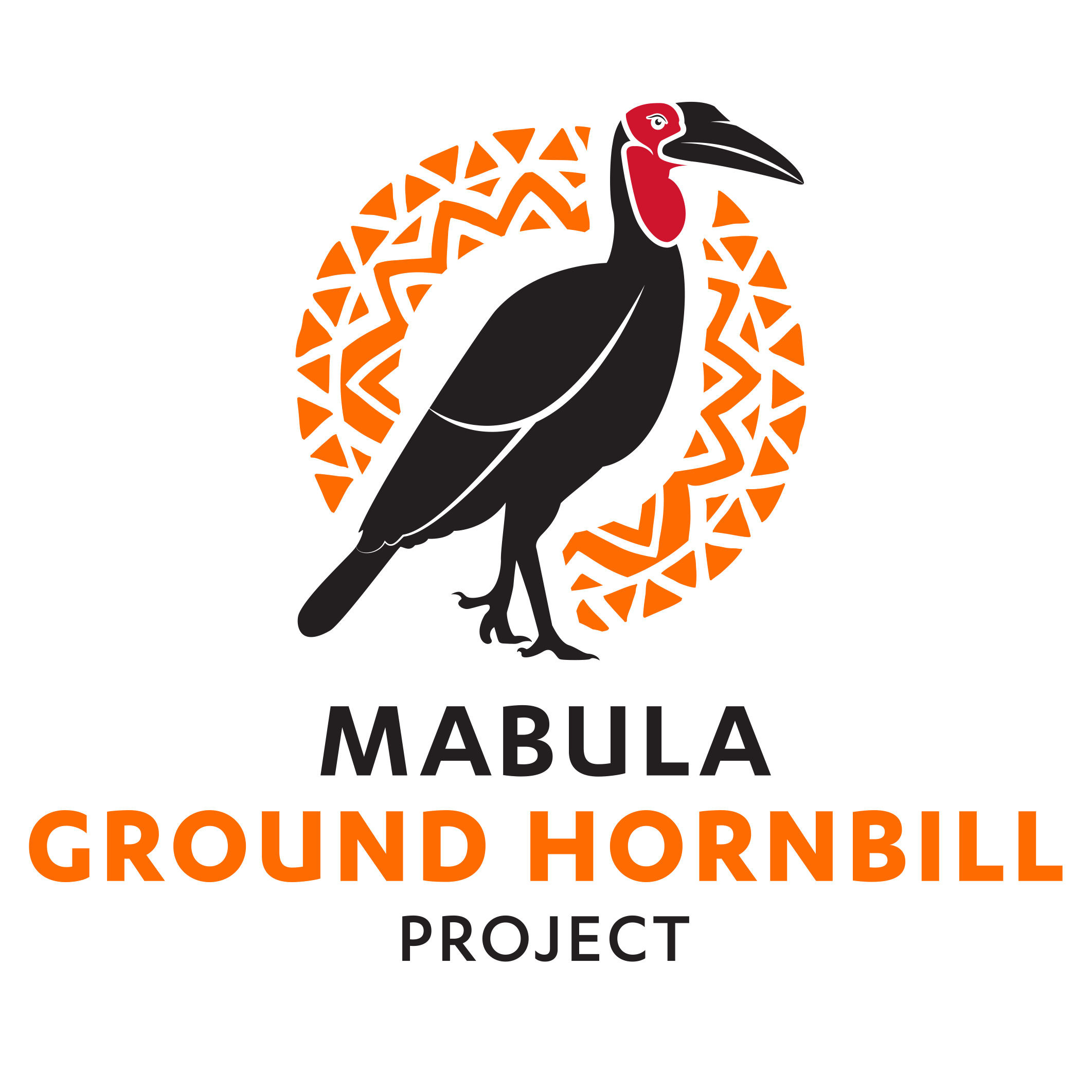THE THUNDERBIRD
MABULA GROUND HORNBILL PROJECT
NEWSLETTER
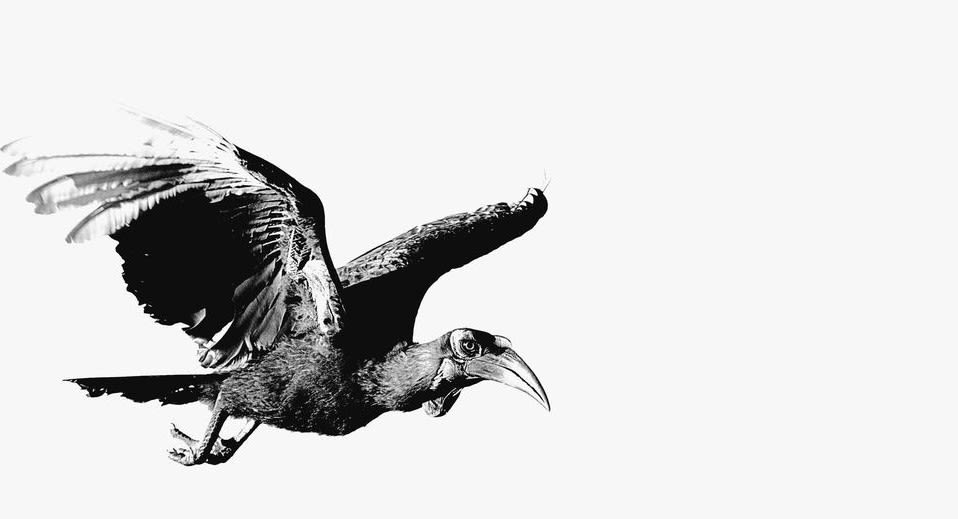
Breeding season 2020
Early rains in October kick-started a few groups into breeding but, in much of the Lowveld area, it wasn't until good rains later in November, that many of the groups finally settled down to breed.
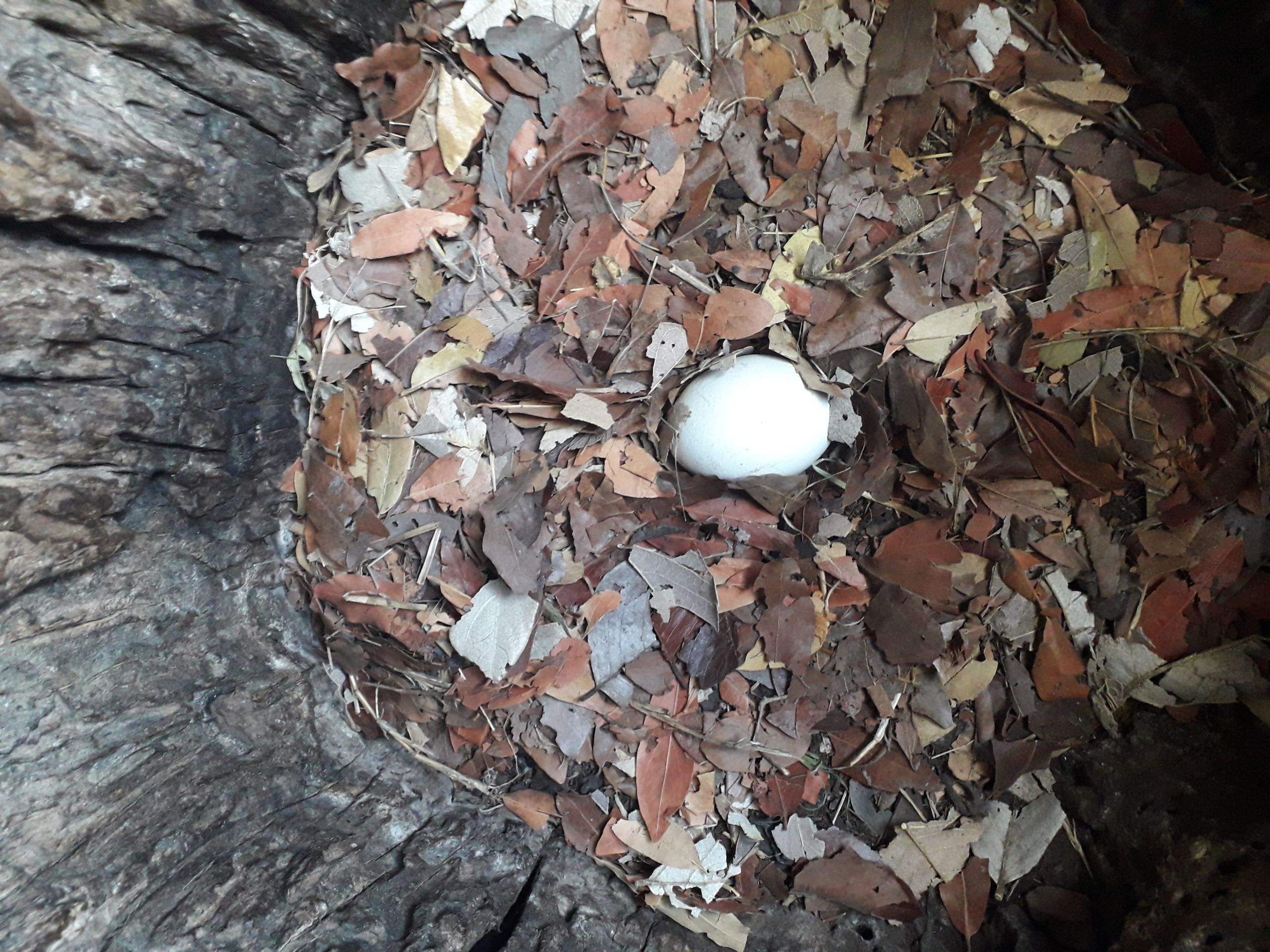
Reintroduced groups breeding
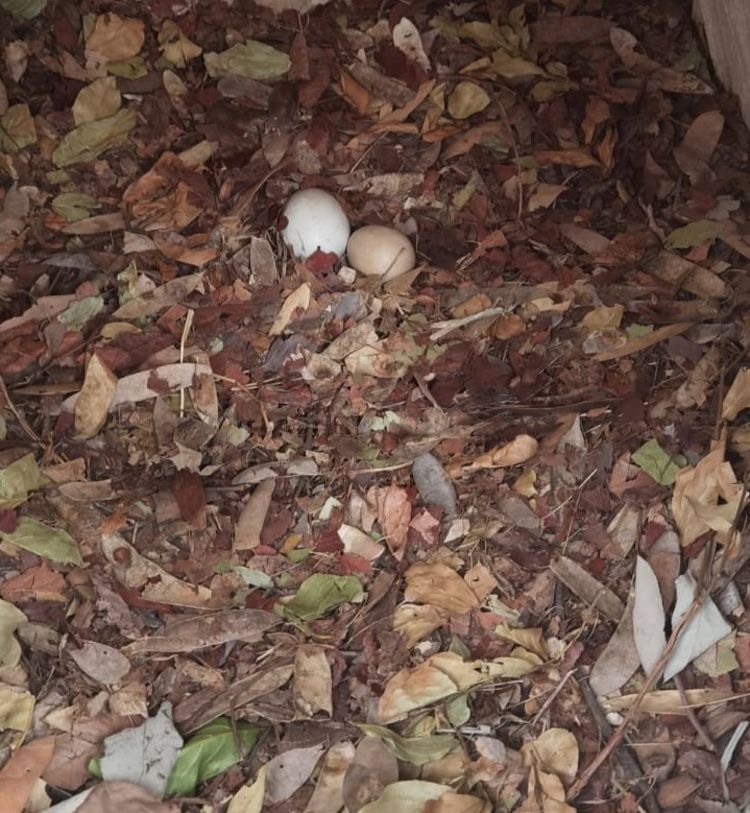
GROUP 1 - this was a weird one for sure! This is only this female's 2nd breeding attempt. She also laid a single egg in 2018 and incubated it successfully. However, in following up on her progress this year a smaller, differently-coloured, egg appeared on the nest. A guinea-fowl? But how?
GROUP 1 - this was a weird one for sure! This is only this female's 2nd breeding attempt. She also laid a single egg in 2018 and incubated it successfully. However, in following up on her progress this year a smaller, differently-coloured, egg appeared on the nest. A guinea-fowl? But how?
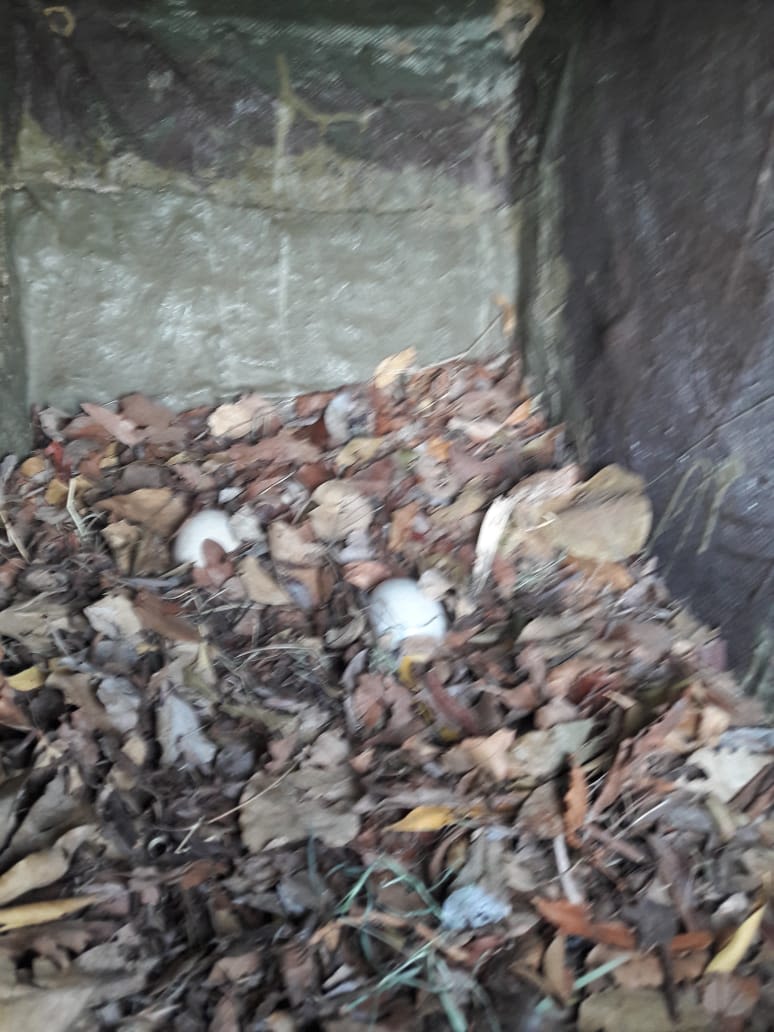
GROUP 2: The blurriness of this image is probably due to the shock to the team member who checked this nest. This 10-year old female has never laid, and this season showed no sign of extended time in the nest, yet has laid not one, not two, but three eggs in her first breeding attempt. She did not incubate them and cracked one, but we are thrilled that she finally decided to give this breeding thing a try.
GROUP 2: The blurriness of this image is probably due to the shock to the team member who checked this nest. This 10-year old female has never laid, and this season showed no sign of extended time in the nest, yet has laid not one, not two, but three eggs in her first breeding attempt. She did not incubate them and cracked one, but we are thrilled that she finally decided to give this breeding thing a try.
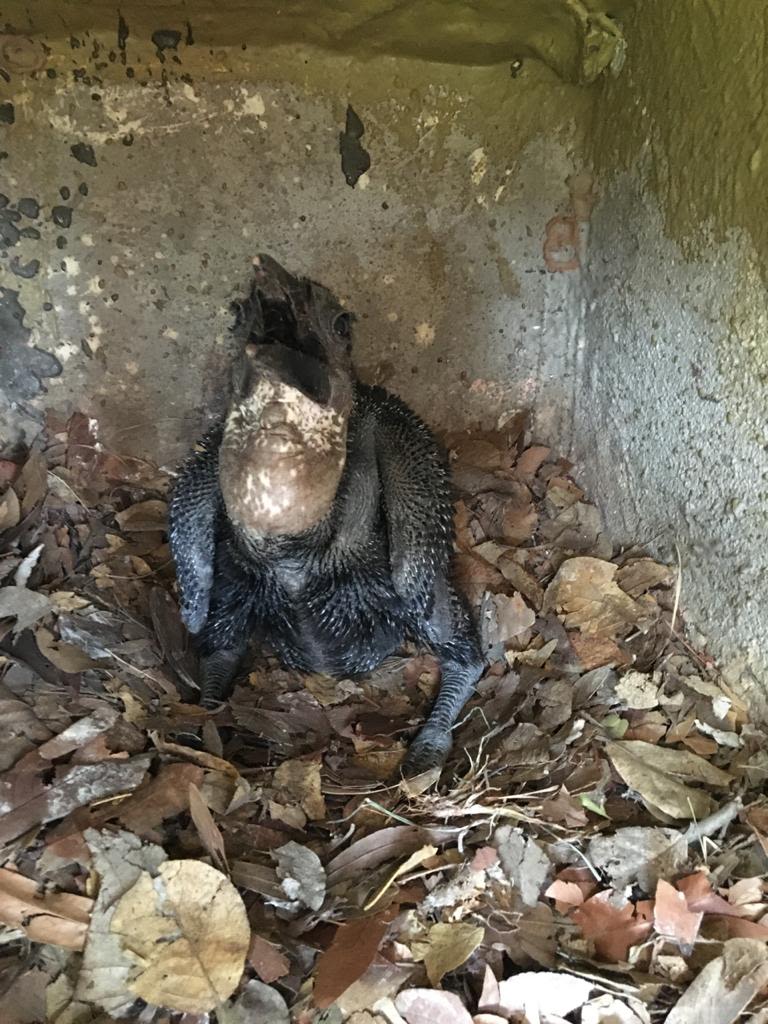
GROUP 3: This is the winning group this season. Here is the first hatched chick, growing happily in the nest, cared for its group, whilst the second-hatched chick, naturally doomed to die, is being reared by the team at the Baobab centre at Loskop Dam Nature Reserve.
GROUP 3: This is the winning group this season. Here is the first hatched chick, growing happily in the nest, cared for its group, whilst the second-hatched chick, naturally doomed to die, is being reared by the team at the Baobab centre at Loskop Dam Nature Reserve.
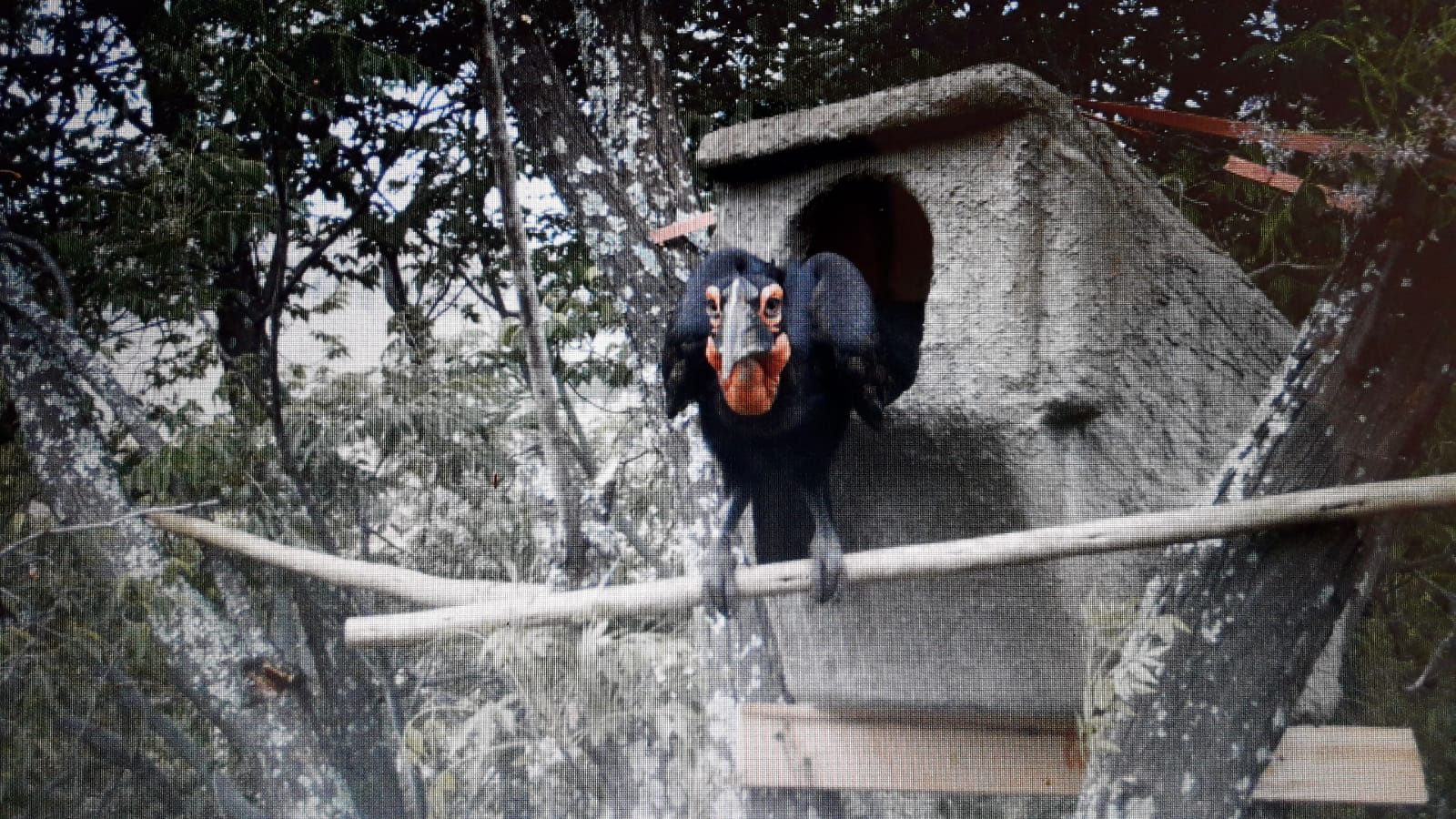
The mama from GROUP 3 was very protective of her nest.
The mama from GROUP 3 was very protective of her nest.
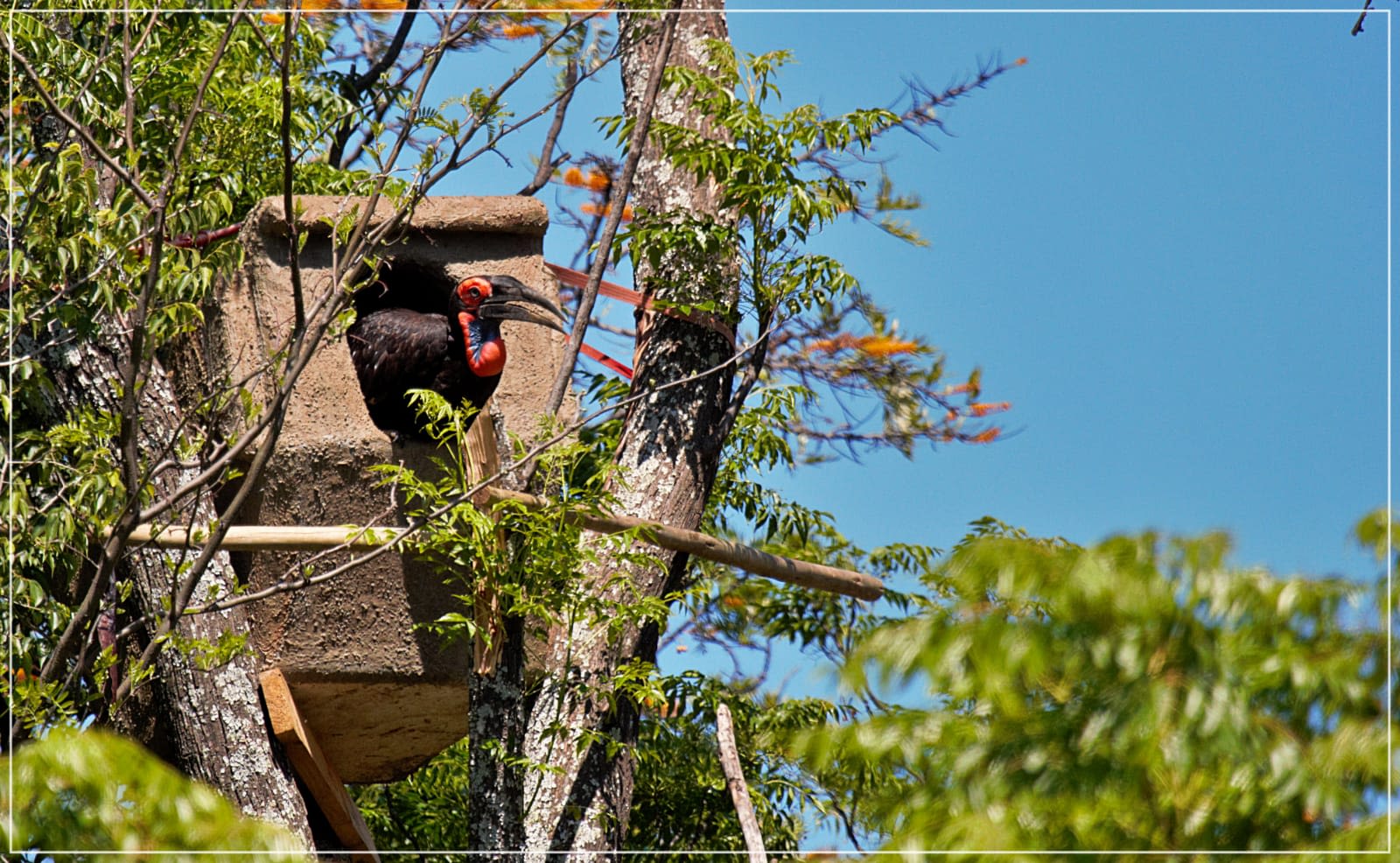
Group 4 was only reintroduced in 2020 and so are still finding their feet - but they have found, and are taking a healthy interest in the artificial nest provided.
Group 4 was only reintroduced in 2020 and so are still finding their feet - but they have found, and are taking a healthy interest in the artificial nest provided.
Harvest from wild nests
We have two parent-reared and three wild chicks harvested thus far, of which four are still going strong.
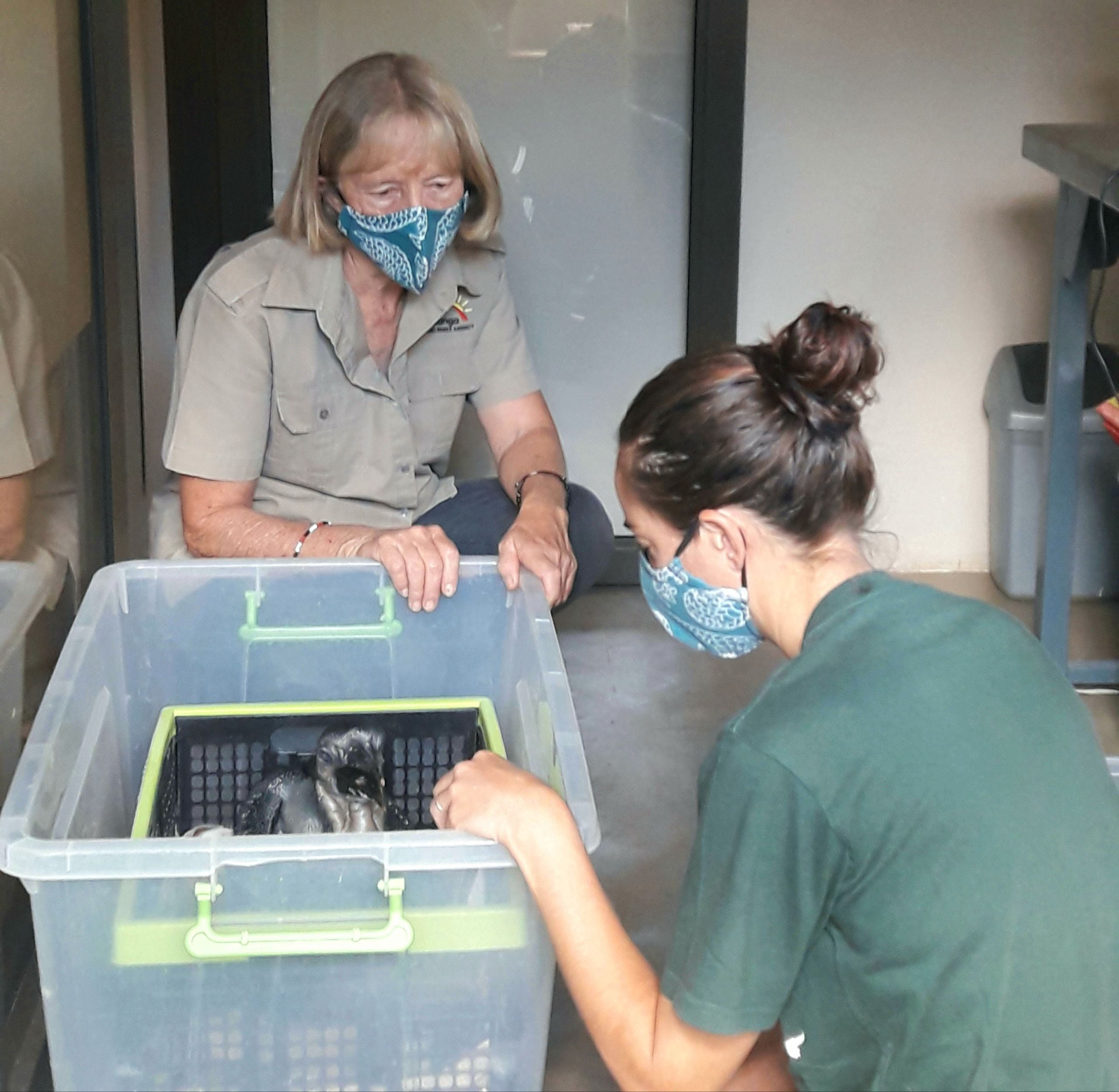
TEAM BAOBAB: Delecia Gunn (Mpumalanga Tourism and Parks Agency) and Natasha Nel (MGHP) are doing an incredible job of rearing this year, despite the world being in turmoil.
TEAM BAOBAB: Delecia Gunn (Mpumalanga Tourism and Parks Agency) and Natasha Nel (MGHP) are doing an incredible job of rearing this year, despite the world being in turmoil.
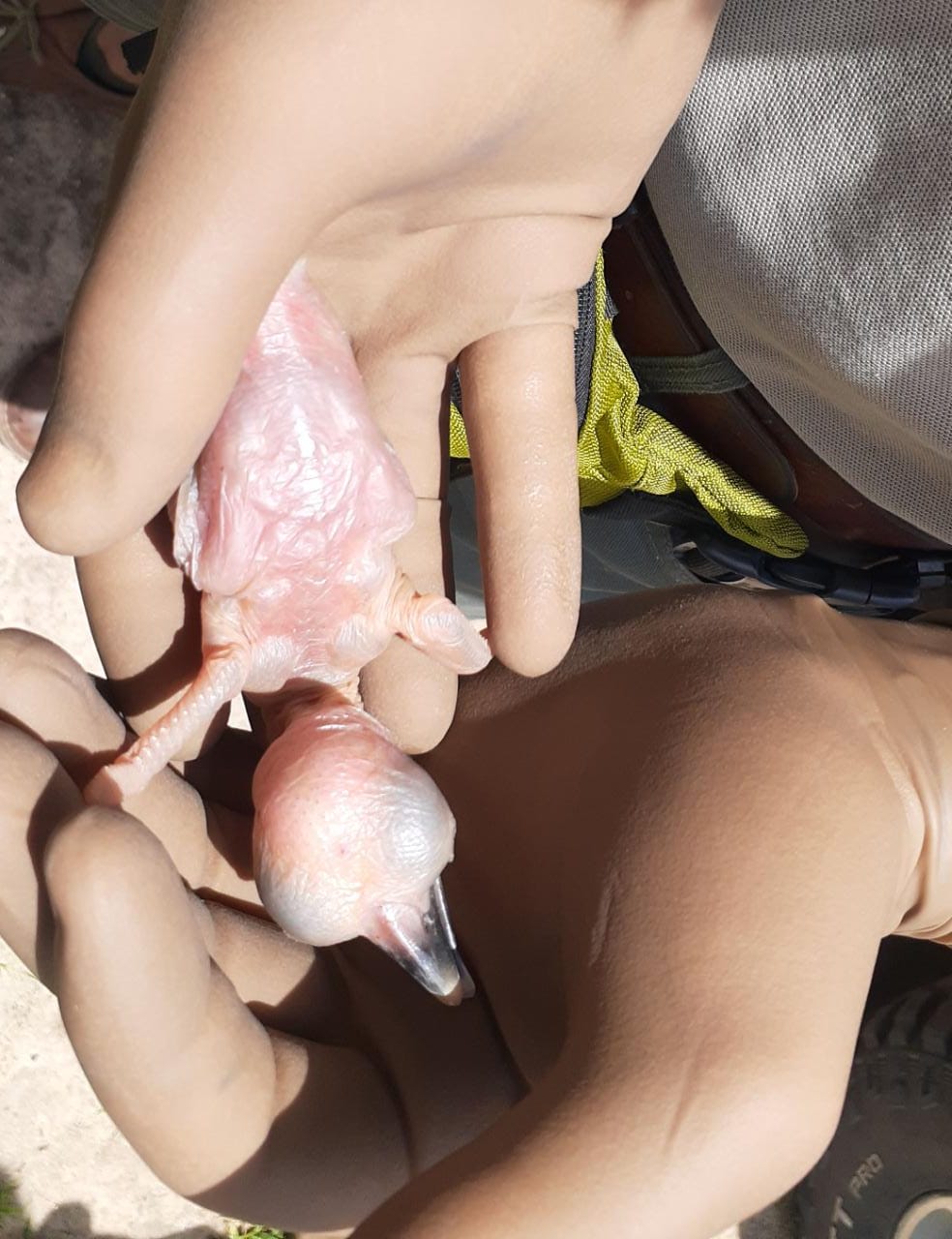
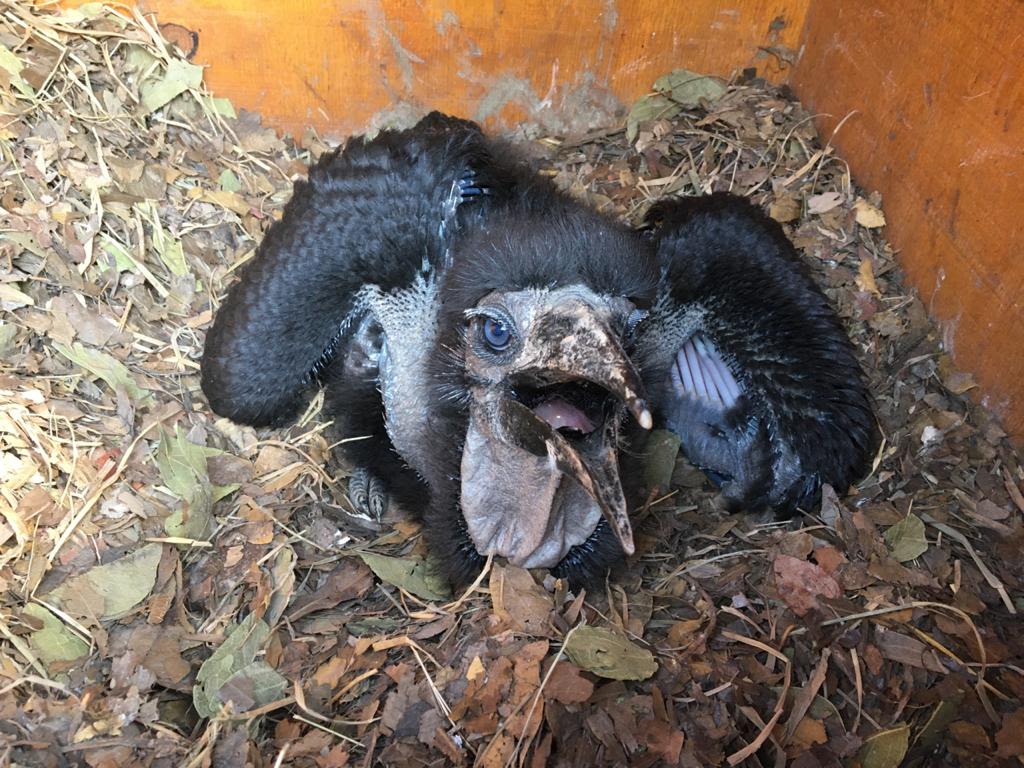
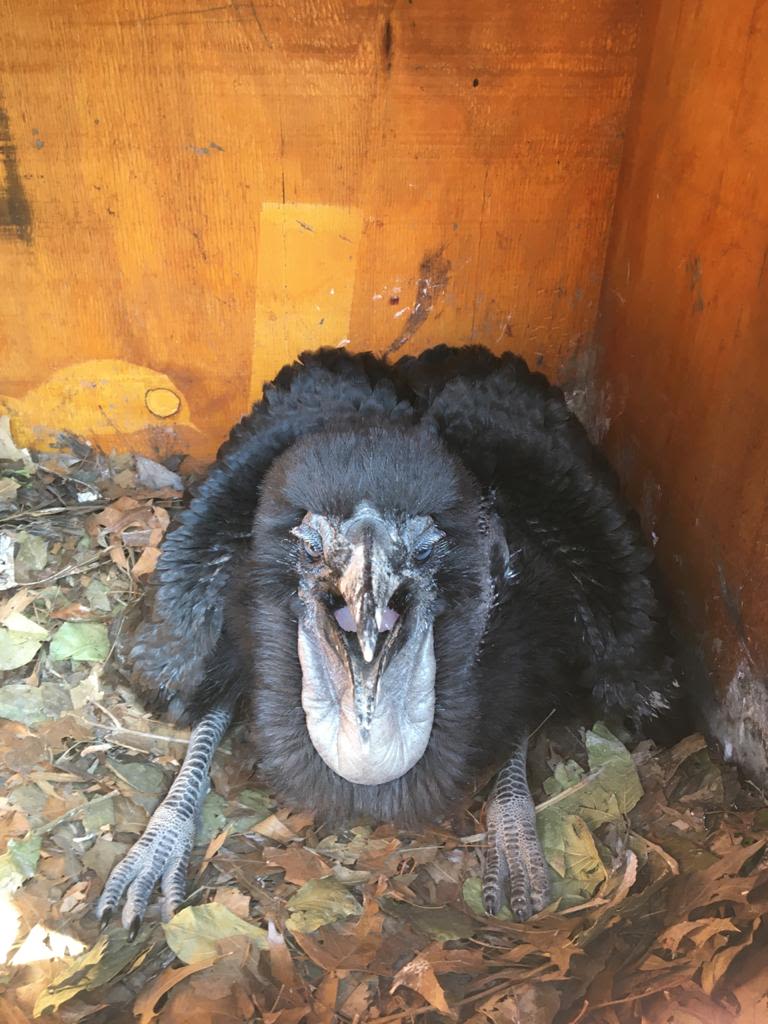
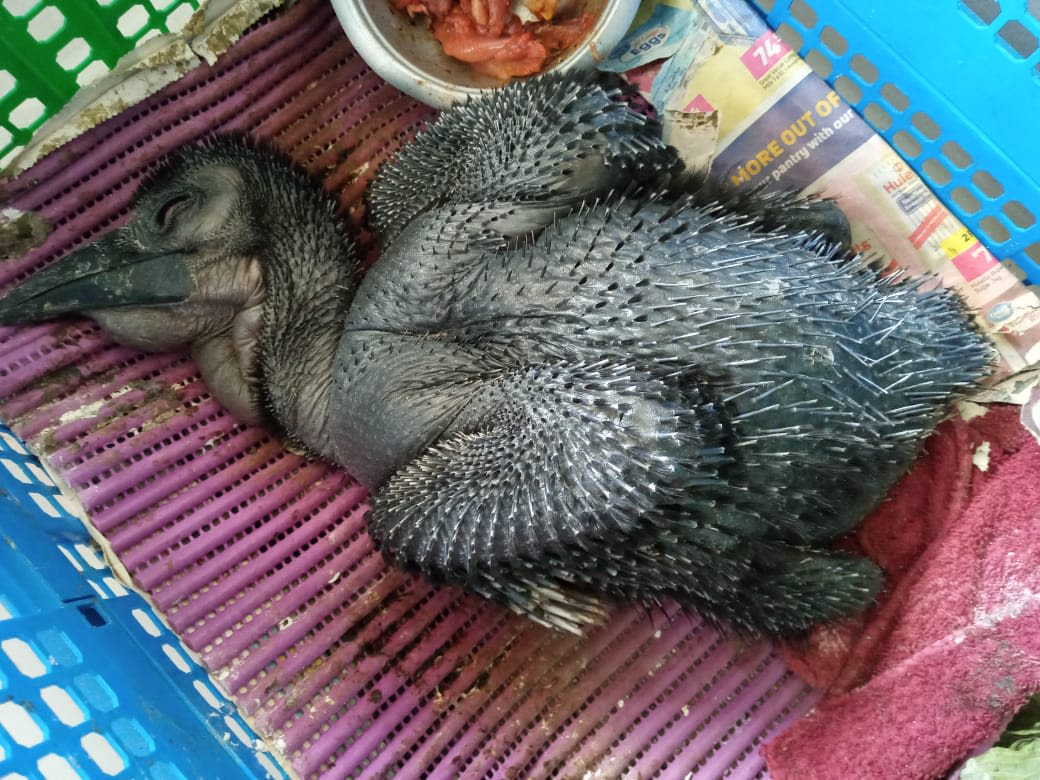

The newest little recruit, Sparta, being carefully taken from the nest.
The newest little recruit, Sparta, being carefully taken from the nest.

Kolisi2020
Kolisi2020

Parent-reared, with a little help from the Loskop team, little Khekheleza-Alf is thriving.
Parent-reared, with a little help from the Loskop team, little Khekheleza-Alf is thriving.

Little Moutse2020, harvested from the wild free-roaming reintroduced group at Loskop Dam Nature Reserve, under the care of Mpumalanga Tourism and Parks Agency, decided on a sleepy new year celebration.
Little Moutse2020, harvested from the wild free-roaming reintroduced group at Loskop Dam Nature Reserve, under the care of Mpumalanga Tourism and Parks Agency, decided on a sleepy new year celebration.
CITIZEN SCIENCE GOES LARGE
in our largest protected area: Kruger National Park
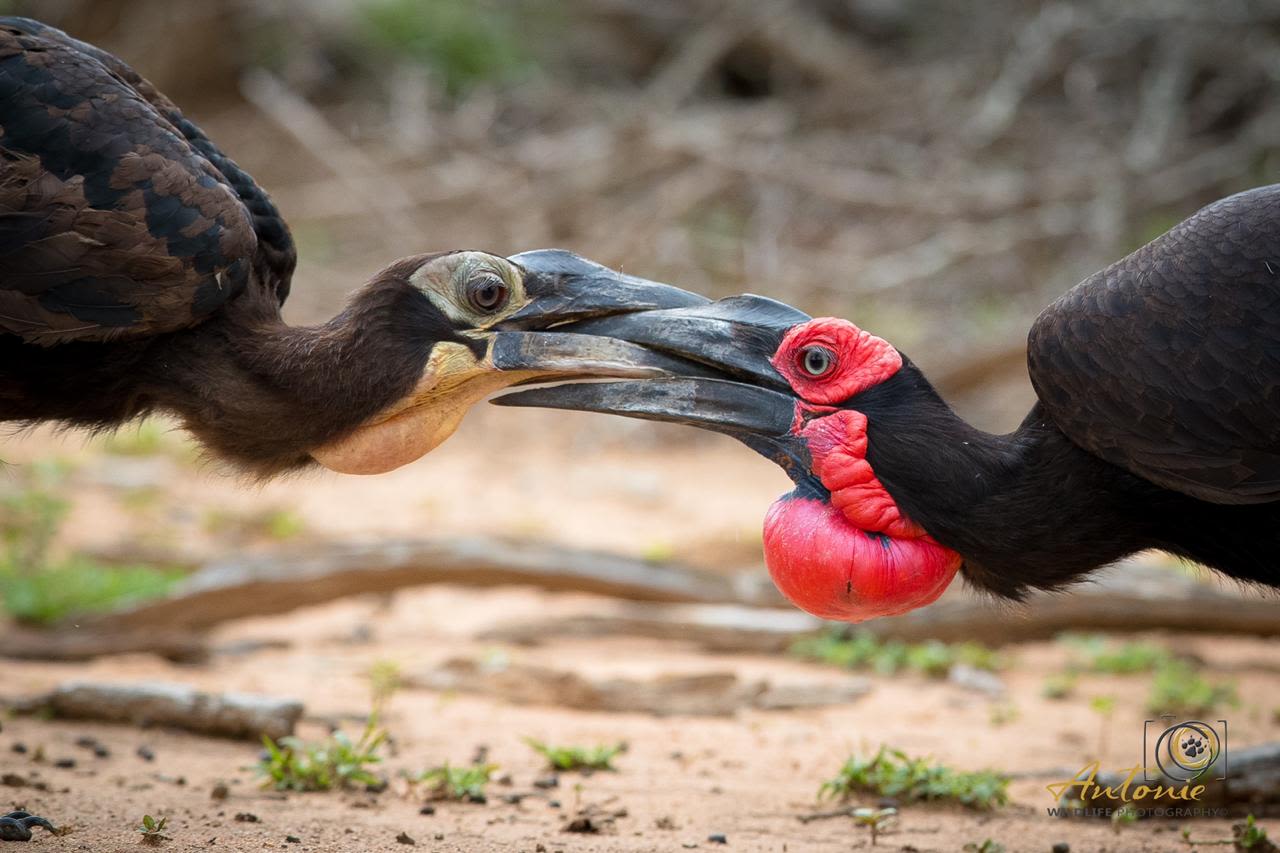
TAKING STOCK: Kruger hornbills not Kruger rands
This year, to reinstate the Kruger National Park nest and citizen science monitoring, and put up posters at all tourist destinations within the Park, the team covered over 5000 km in a month. This project is a collaboration with SANParks and the Endangered Wildlife Trust.
A total of 65 nests were assessed, of which 18% have sadly collapsed since the last monitoring took place in 2015. Of the remaining nests 37% where active, with eggs already laid in nine of the nests, 45% were inactive (we think due to the intensive heat and late rains), but we hope that some may have kicked into action when the December rains finally arrived. When we return to check the nests we will be able to see if this is indeed the case.
As usual, working in Kruger was an absolute pleasure. We thank our game-guards who made the long hot days fun with stories of their Kruger experiences.
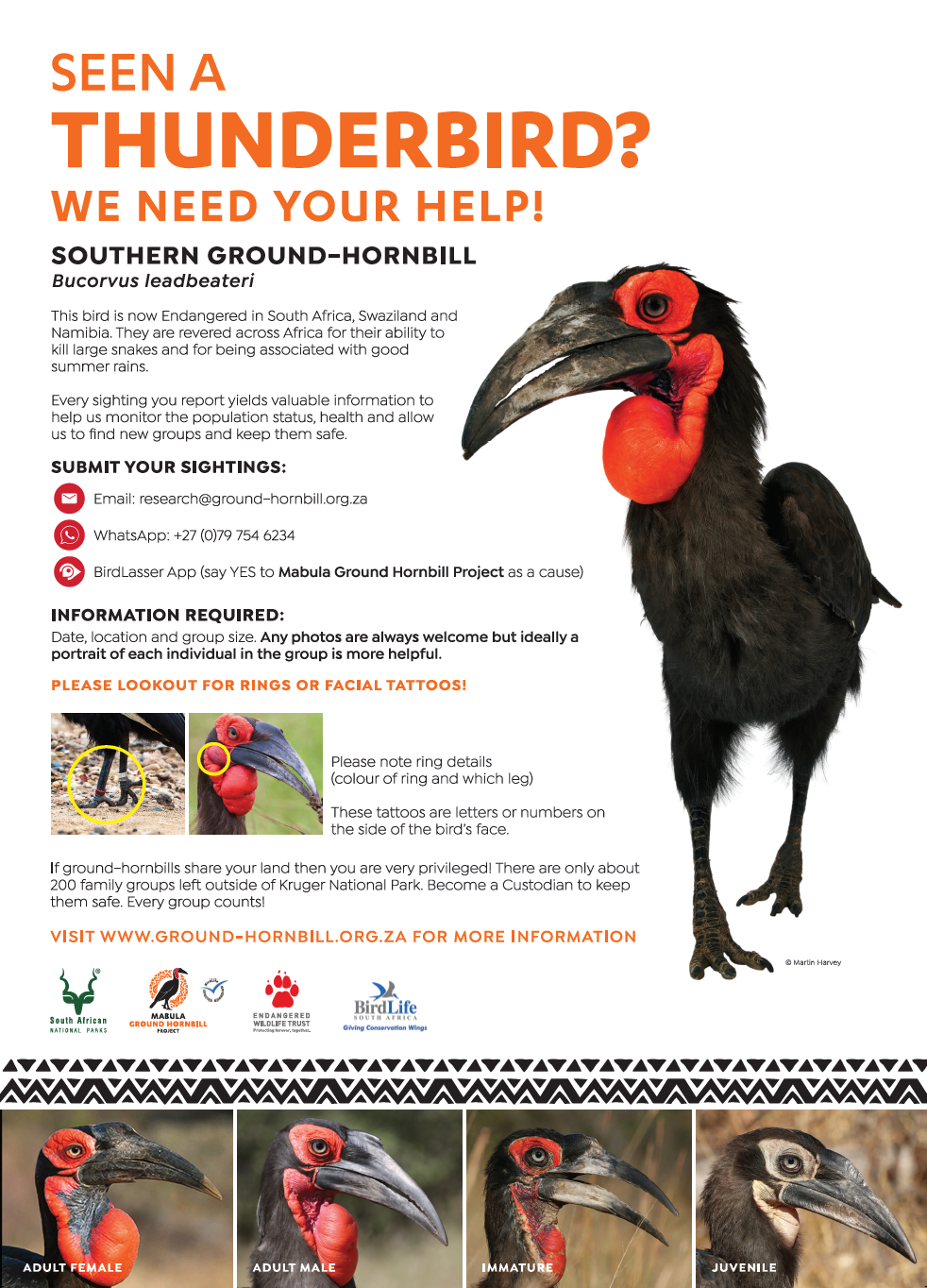
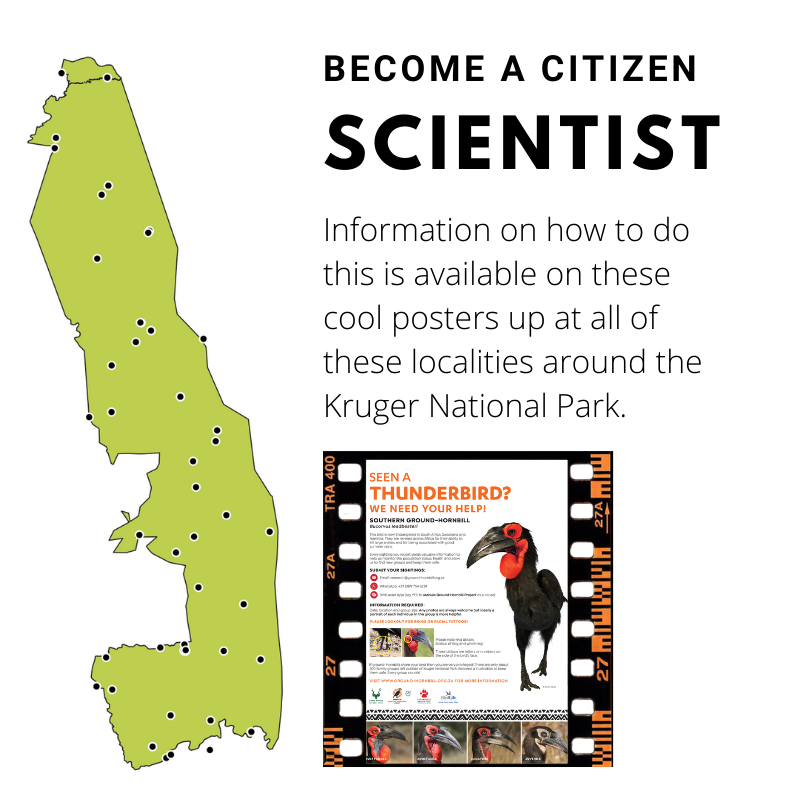
Since the posters went up and the Project has been widely shared on the SANParks social media platforms, our sighting records from within the Park have soared. In November alone, we received a doubling of the average number of email sightings we have been receiving monthly, and a ten-fold increase in sightings reported to our Whatsapp hotline.
Naturally, being in the field for a month allowed us to add a bunch of our own records, which is always lovely. We are now getting about 400 records a month - Lowveld records are wonderful but records from beyond the borders of protected as are like gold! In the next newsletter, once we have analysed the 2020 data, we will be able to give you feedback and also highlight the areas that will need more of your help get allow us to see the BIG PICTURE.
New nest installations
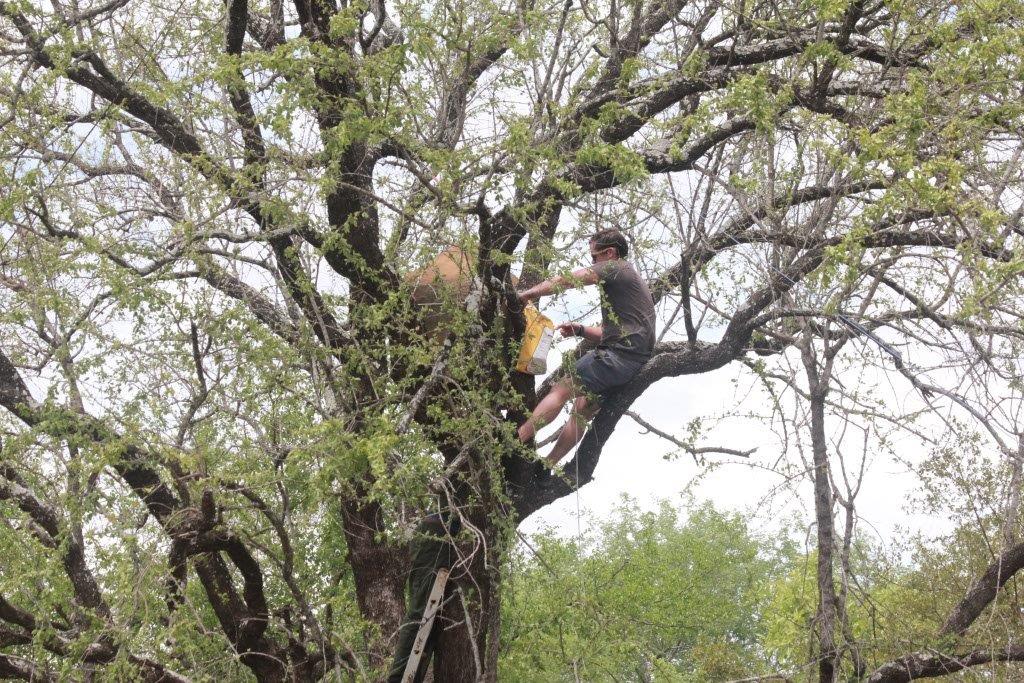
We, together with collegues, sponsors, partners and friends, have installed a total of seven new nests this season. It brings us in immense joy every time one of our nests become adopted by a group in need of an awesome nest.
too hot?
this year we have received many photographic records of birds showing extreme heat stress as multiple days of above 40 degrees Celcius temperatures take their toll.
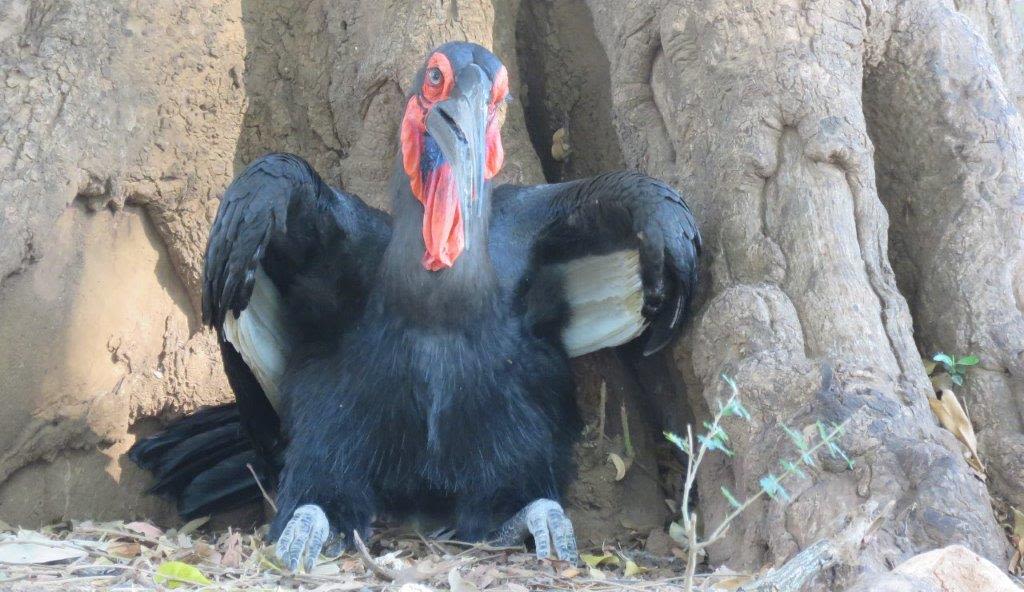
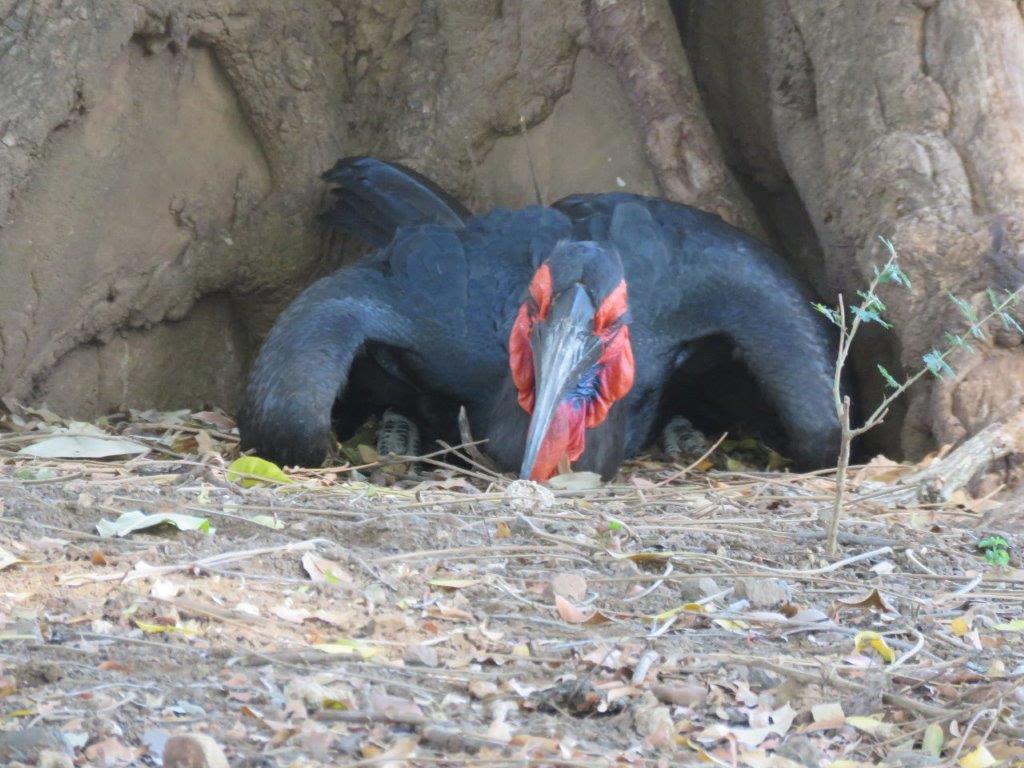
In 2021 we will undertaking a full analysis of what rising global tempertures will means for this species with support of IUCN SSC Climate Change Specialist Group using their Assessing Species’ Vulnerability to Climate Change system to ensure our conservation planning will support this species into a hotter future.
ground-hornbills & elephants ...
& fungus & fire & wind & floods
A collaboration with Elephants Alive & the Fitzpatrick Institute
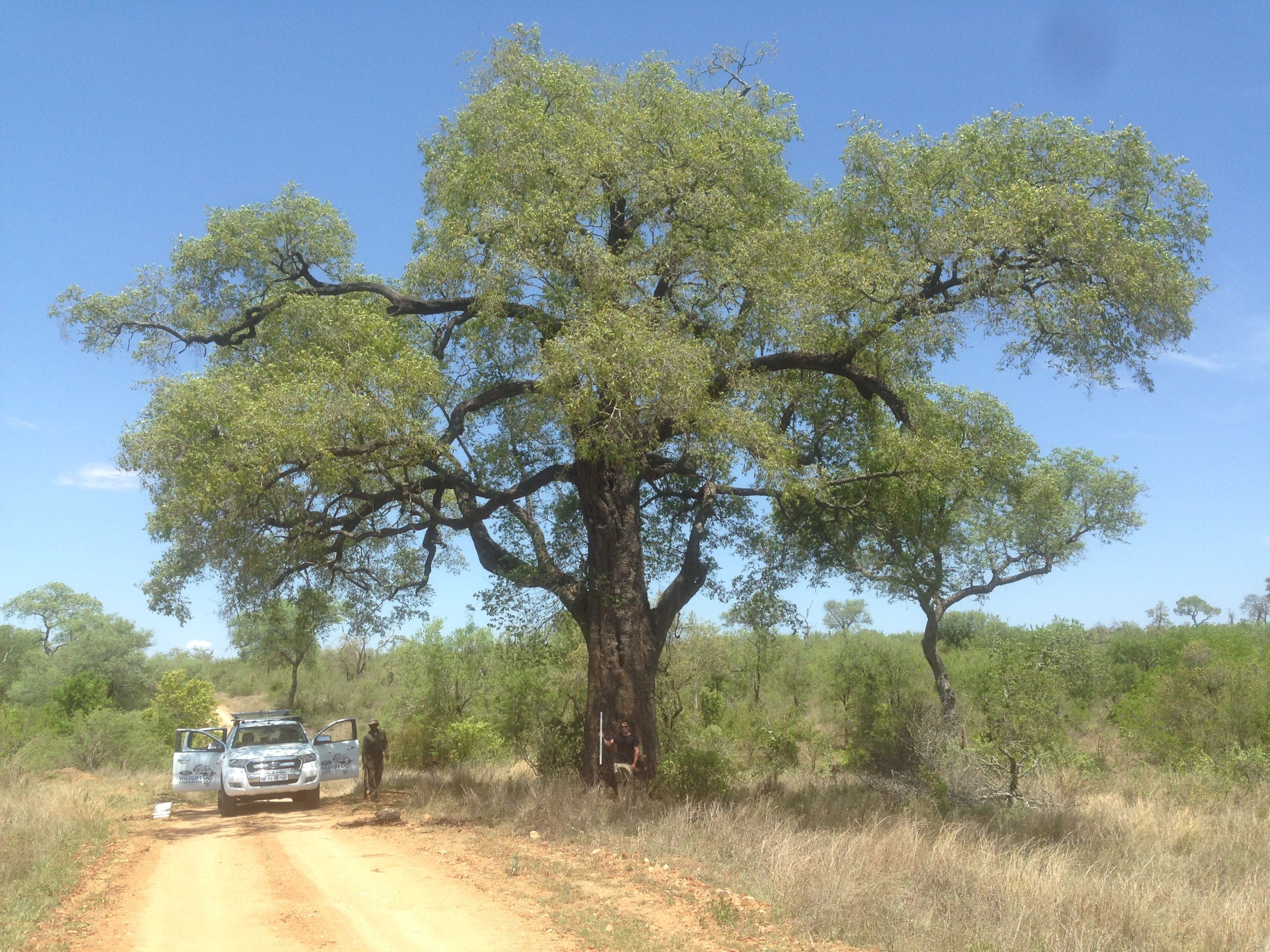
Each year, when we do our annual nest monitoring, we also assess the health of the trees that the nest hollows are in. We, and the APNR team, strictly follow the protocols laid out by Elephants Alive to make sure our data are comparable and are able to be used as part of a greater meta-analysis of the dynamics of our iconic big trees.
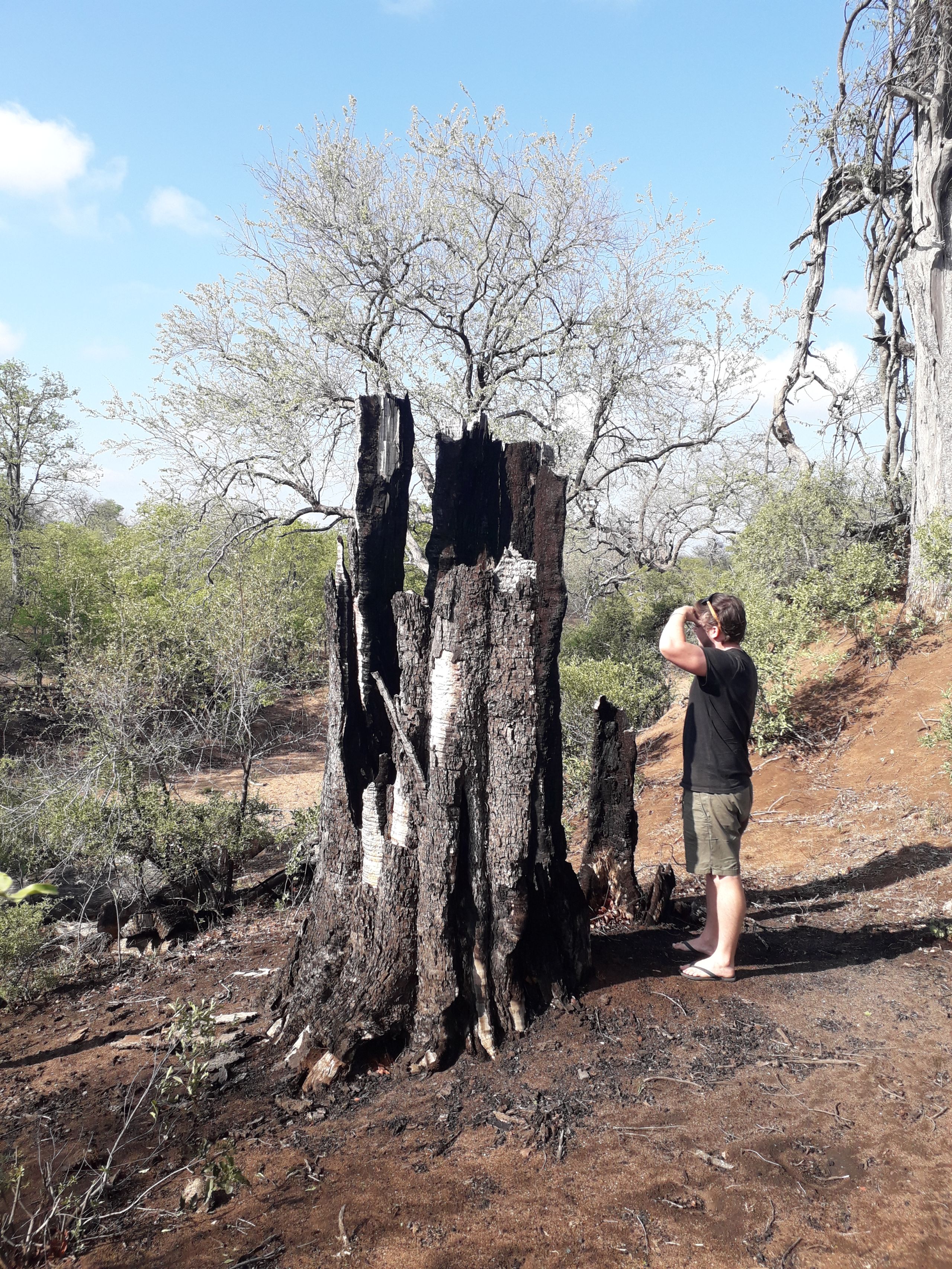
The power of fire. Another nest lost. Jarryd Alexander is leading this project.
The power of fire. Another nest lost. Jarryd Alexander is leading this project.
THE LIMPOPO RIVER VALLEY
ground-hornbills in baobab country
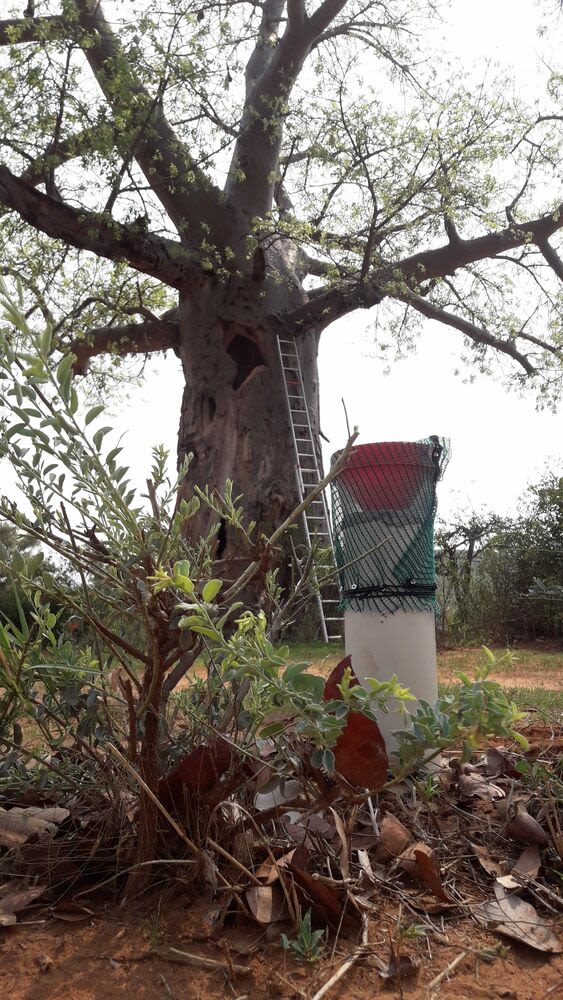
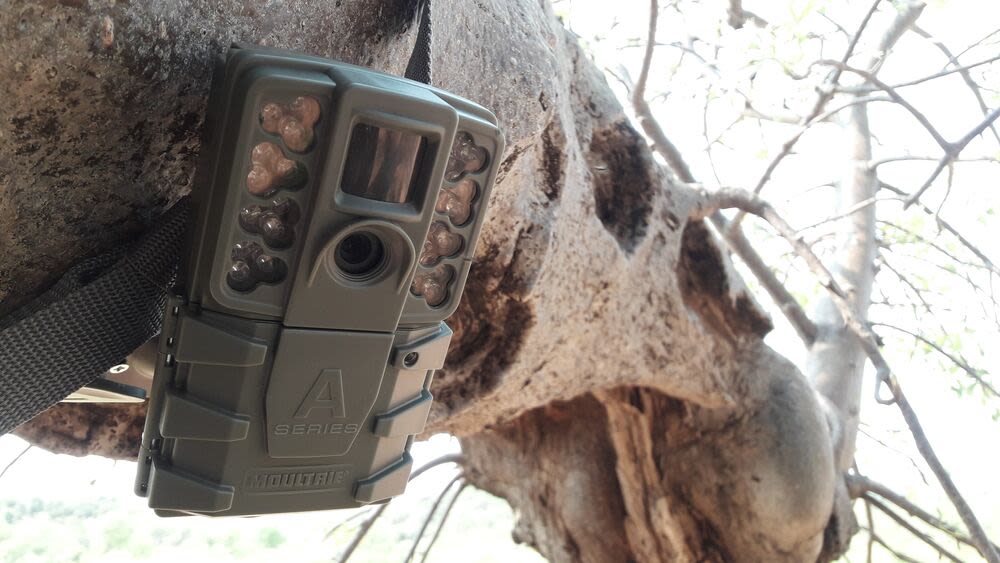
Each nest has a camera trap installed.
Each nest has a camera trap installed.
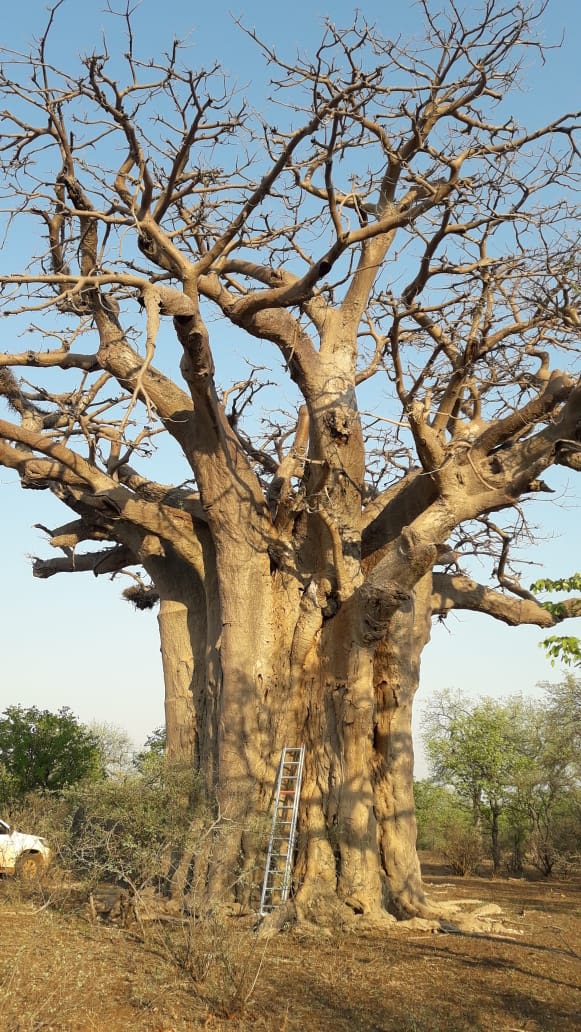

We have, in addition to our collaboration with the Southern African Conservation Trust in the design of the comic books, partnered with the Global Conservation Force to help us spread our education programme - working with the Kariega and Amakhala Foundations in the Eastern Cape, and the Nourish NGO, working in the Bushbuckridge community that borders on the Kruger National Park.
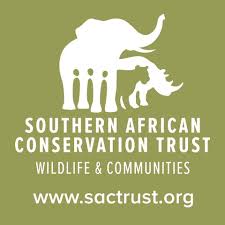
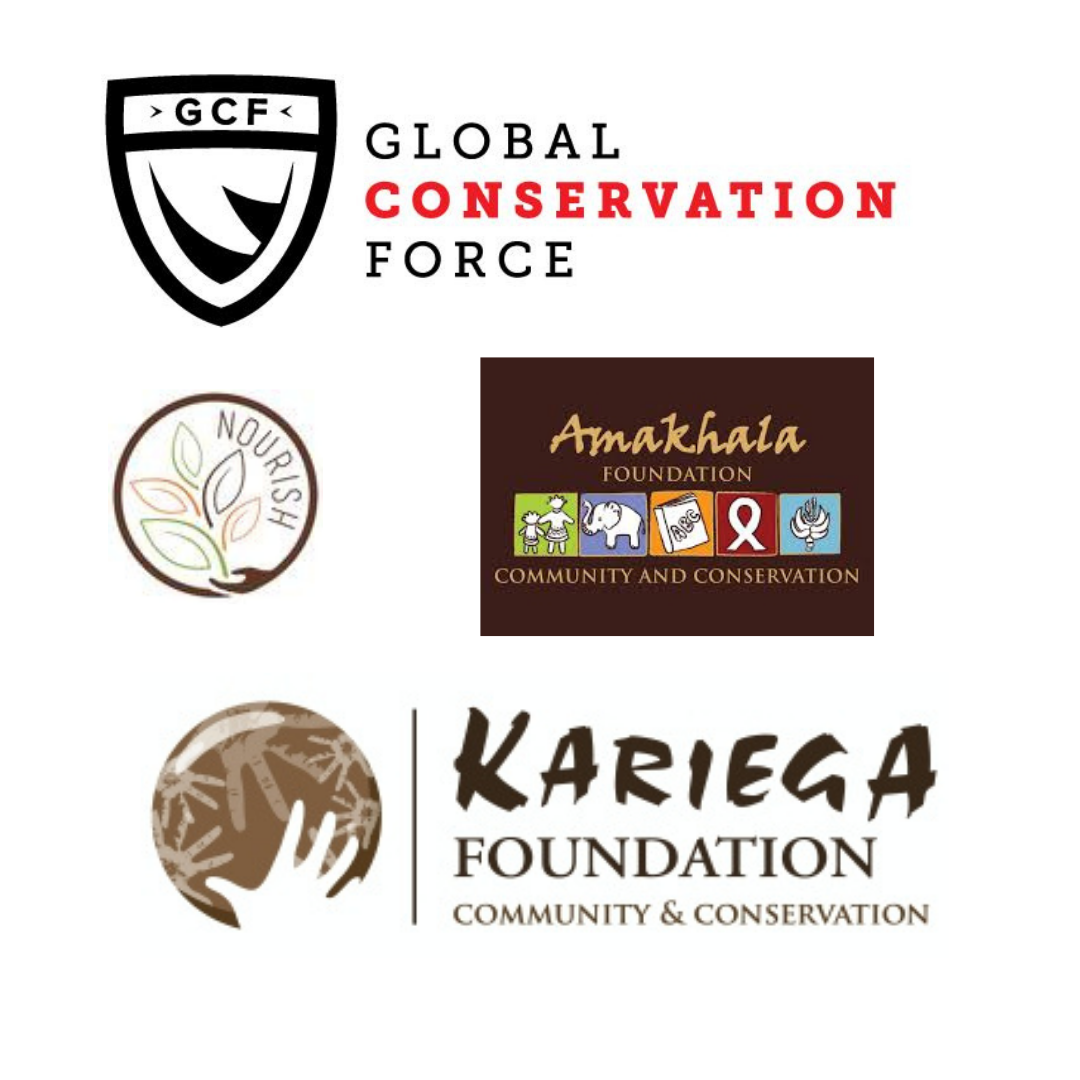
Global Conservation Force is supporting our education partnership with Nourish, the Amakhala and Kariega Foundations.
Global Conservation Force is supporting our education partnership with Nourish, the Amakhala and Kariega Foundations.
Artists for Conservation Capacity
Led by the Dee and Barrie Guy for the Alf Rewin Conservation fund
A massive thank you to all the talented artists that contributed to this amazing event - for us, it has been so much fun to see all the interpretations of these special birds.
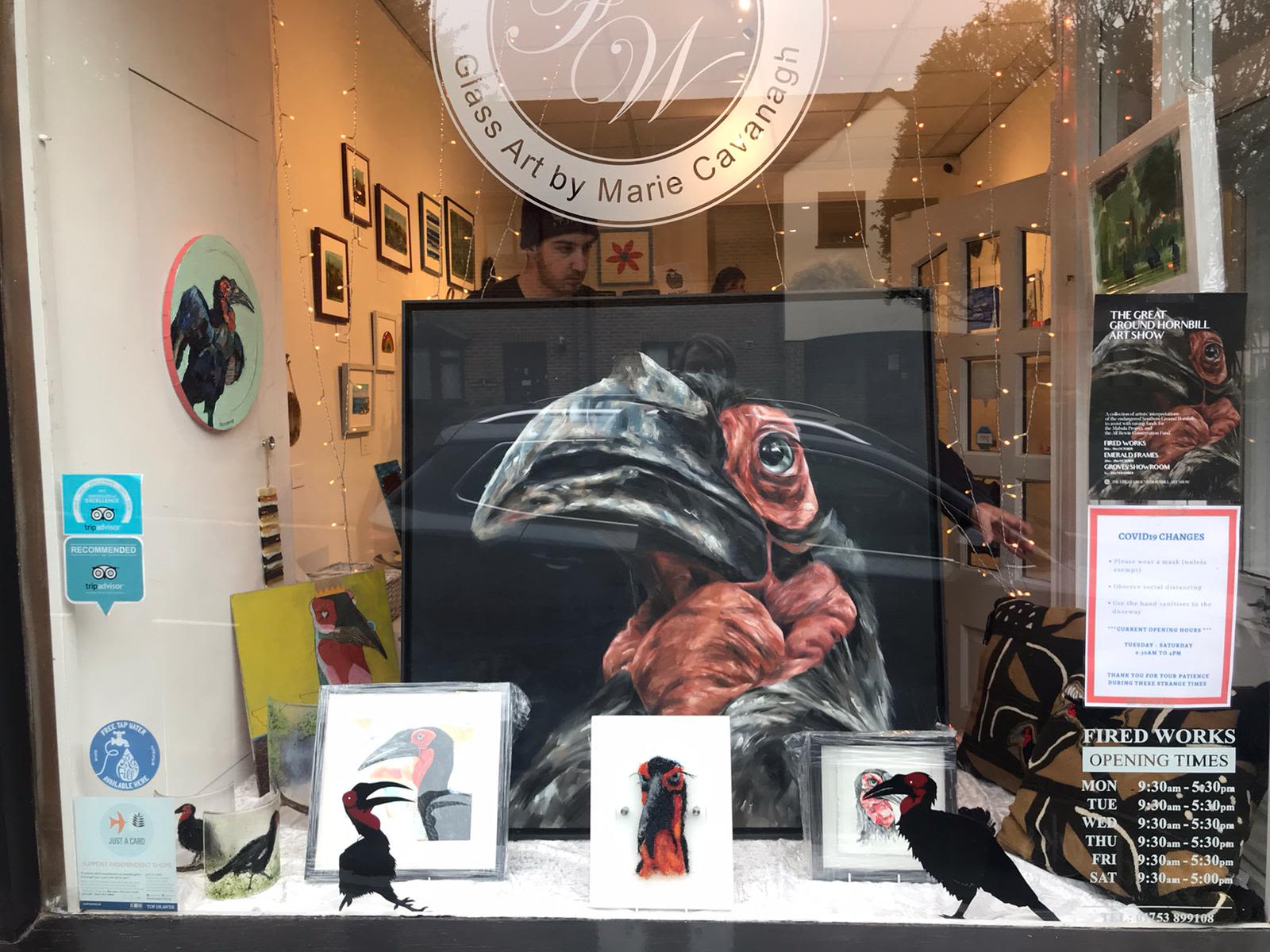
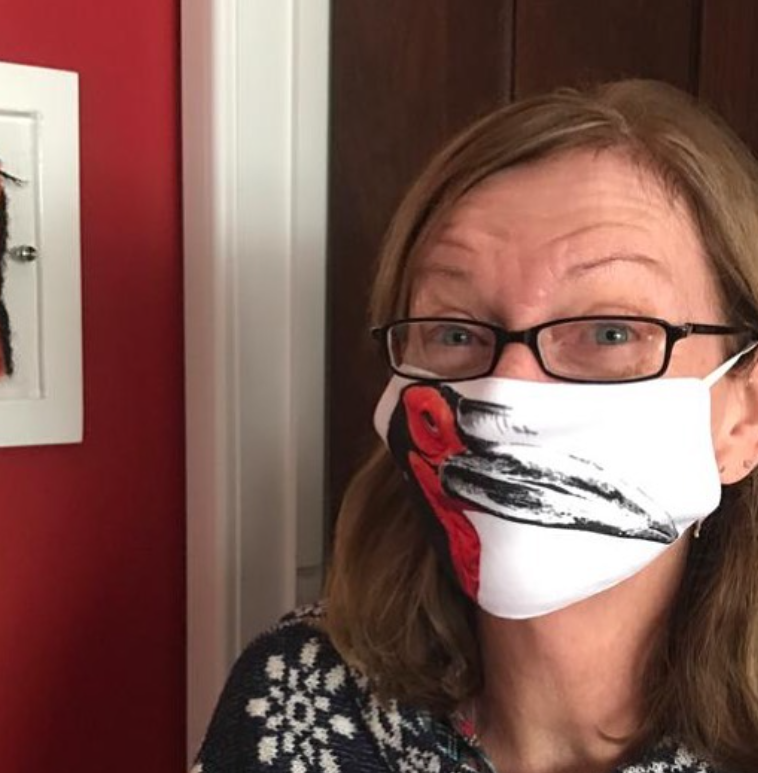
Dee Guy has led this charge - she has a background in fine art - and it is beautiful to see this come to the fore.
Dee Guy has led this charge - she has a background in fine art - and it is beautiful to see this come to the fore.
We are doing well this year towards reaching our target of R1 million. Once this legacy fund is secure we will be able to support one MSc student or several conservation interns a year to build their own capacity and support us in our ongoing quest to understand this difficult beast.
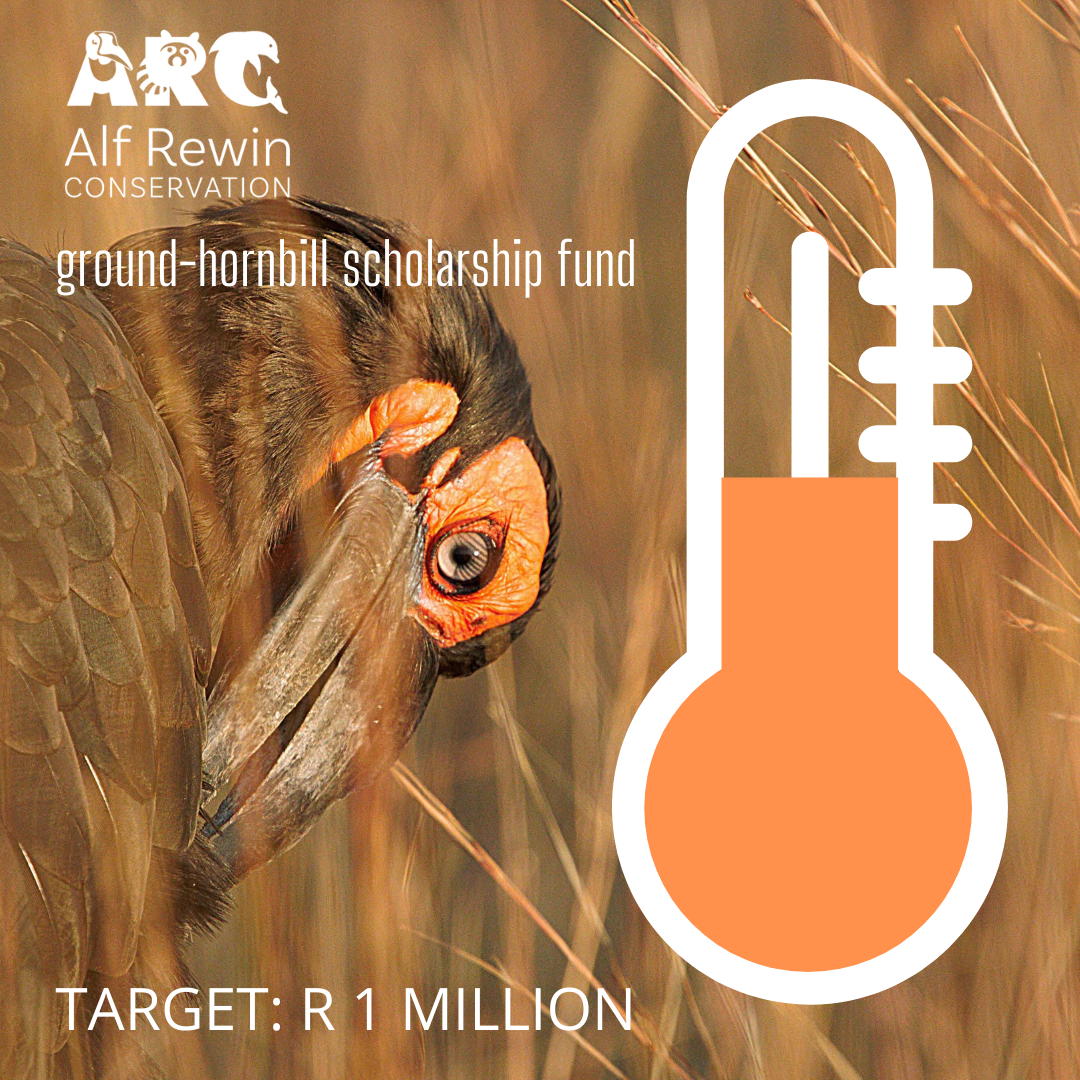
We are over the R400 000 mark so almost halfway!! Remember any contributions to this find, be it in South Africa, or the UK, is a tax-deductible option.
We are over the R400 000 mark so almost halfway!! Remember any contributions to this find, be it in South Africa, or the UK, is a tax-deductible option.
SHOWING GROUND-HORNBILL HASHTAG LOVE
# thunderbirdthursday has reached over 2 million (2 226 282 to be precise :) ) people around the world - thank you to everyone who shares their ground-hornbill photos and care every Thursday under this hashtag. Send us your photos if you would like to be our weekly thunderbird star.
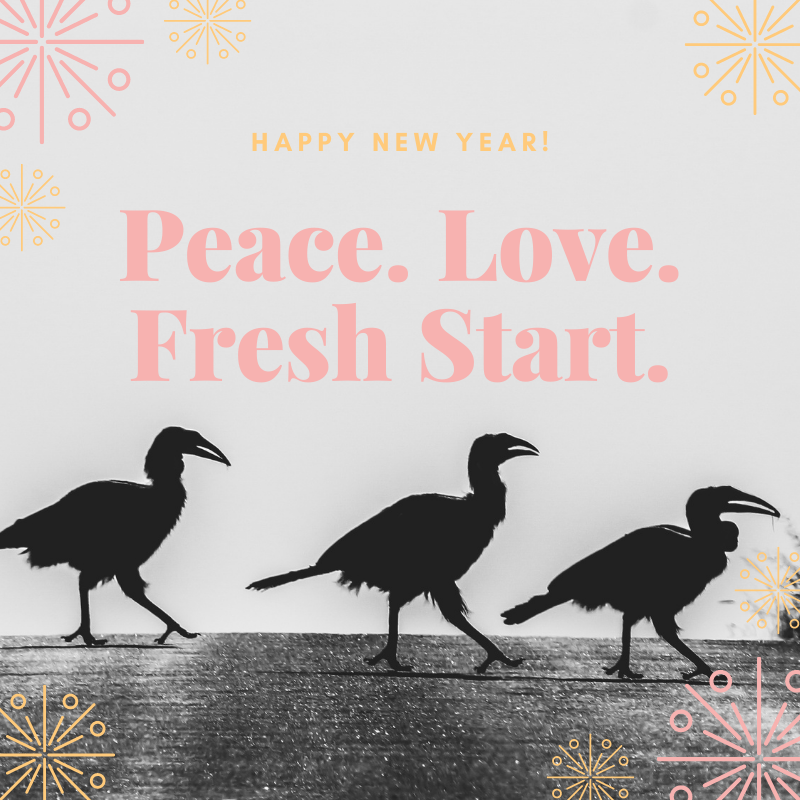
If you would prefer not to receive our newsletters please just drop us a line here.
If you like our newsletters please feel free to share with friends and family - the more people who love ground-hornbills the better the chances of finding a safe space in our world.

